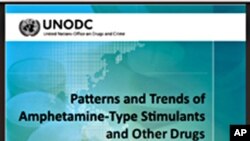A United Nations report on international drug trafficking is warning of increasing demand and supply of amphetamine type stimulants (ATS) across Asia, with Burma remaining the main source of production. But officials are also warning of the emergence of Iranian and West African drug trafficking gangs infiltrating Asia.
The United Nations, in a report on the drug trafficking trends in Asia, says amphetamine type stimulants (ATS) and other synthetic drugs are now "the primary drug threat", displacing traditional used drugs such as heroin, opium or cannabis.
The report released Thursday by the United Nations Office on Drugs and Crime (UNODC) says in the past year between 3 million and 20 million people consumed ATS. The highly-addictive drugs can be made from pseudoephedrine, a decongestant found in over-the-counter cold medicines.
Organized crime
The report also said there is a growing activity of organized crime gangs, especially from Iran and West Africa, which are contributing to the widening drug problem in East and Southeast Asia.
Deepika Naruka, a UNODC official in Bangkok, said a wave of arrests of traffickers from Iran throughout Asia over the past two years had surprised law enforcement authorities."It's a new trend. It's just erupted within a year," Naruka said. "There have been so many arrests in so many countries that we need to find out why it's happening but we need to find out why it's happening but we haven't been able to pinpoint the reason yet."
Role of Iranian nationals
A growing trend of arrests of Iranian nationals attempting to smuggle methamphetamine in crystalline and liquid form has been evident in Japan, Indonesia, Malaysia, the Philippines and Thailand.
UNODC officials say preliminary research says several factors lay behind the trend including poverty.
In Asia a trend of increasing numbers of people taking methamphetamines in pill or crystalline form was evident in Brunei, China, Burma, Indonesia, Laos, Papua New Guinea, Malaysia and Vietnam.
Burma being main source
Burma, also known as Myanmar, remains the primary source of methamphetamines. There clandestine laboratories operate in eastern border regions under the control of ethnic armies and Chinese gangs. Reports put the total production of ATS tablets in Burma at over one billion a year.
Burma's military linked with trade
The UNODC says Burma's military is also involved in broader drug trafficking.
Gary Lewis, UNODC regional representative for East Asia and the Pacific in Bangkok, says corrupt government elements are likely linked with the trade.
"If you've got a mix of individuals and groups associated and some connected to the government involved in a region where there is such political flux and such a high degree of corruption which the Myanmar authorities would themselves admit - you are going to get individuals and groups on all sides of the political spectrum involved in the movement of drugs," said Lewis.
Drug agency warns
The UNODC also warned of the growing use and trafficking of ketamine, a drug used in human and veterinary medicine, in East and South East Asia. The UNODC says nearly seven tons of ketamine were seized in 2009, with around 85 percent of global seizures occurring Asia.
The report says economic liberalization and trade while raising local incomes has also enabled growing opportunities for criminal organizations, including production and trafficking of illicit drugs.








